Grating Assembly Dissected in Periodic Bands of Poly (Butylene Adipate) Modulated with Poly (Ethylene Oxide)
Abstract
:1. Introduction
2. Experimental
2.1. Materials and Preparation
2.2. Apparatus
3. Results and Discussion
Crystalline Morphologies of PBA/PEO Blends
4. Iridescence of Periodically Assembled Crystals
5. Conclusions
Author Contributions
Funding
Institutional Review Board Statement
Informed Consent Statement
Data Availability Statement
Acknowledgments
Conflicts of Interest
References
- Woo, E.M.; Nurkhamidah, S.; Chen, Y.F. Surface and interior views on origins of two types of banded spherulites in poly(nonamethylene terephthalate). Phys. Chem. Chem. Phys. 2011, 13, 17841–17851. [Google Scholar] [CrossRef] [PubMed]
- Woo, E.M. Banded Crystalline Spherulites in Polymers and Organic Compounds: Interior Lamellar Structures Correlating with Top-Surface Topology. J. Adv. Chem. Eng. 2015, 5, 2–7. [Google Scholar] [CrossRef]
- Keith, H.D.; Padden, F.J. Banding in polyethylene and other spherulites. Macromolecules 1996, 29, 7776–7786. [Google Scholar] [CrossRef]
- Schultz, J.M.; Kinloch, D.R. Transverse screw dislocations: A source of twist in crystalline polymer ribbons. Polymer 1969, 10, 271–278. [Google Scholar] [CrossRef]
- Eshelby, J.D. Screw dislocations in thin rods. J. Appl. Phys. 1953, 24, 176–179. [Google Scholar] [CrossRef]
- Toda, A.; Taguchi, K.; Hikosaka, M.; Kajioka, H. Branching and Higher Order Structure in Banded Polyethylene Spherulites. Macromolcules 2008, 41, 2484–2493. [Google Scholar] [CrossRef]
- Toda, A.; Kojima, I.; Hikosaka, M. Melting Kinetics of Polymer Crystals with an Entropic Barrier. Macromolecules 2008, 41, 120–127. [Google Scholar] [CrossRef]
- Lotz, B.; Cheng, S.Z.D. A critical assessment of unbalanced surface stresses as the mechanical origin of twisting and scrolling of polymer crystals. Polymer 2005, 46, 577–610. [Google Scholar] [CrossRef] [Green Version]
- Ikehara, T.; Kataoka, T. Relation between the helical twist and S-shaped cross section of the lamellar crystals of polyethylene. Sci. Rep. 2013, 3, 1444. [Google Scholar] [CrossRef] [Green Version]
- Nagarajan, S.; Woo, E.M. Periodic Assembly of Polyethylene Spherulites Re-Investigated by Breakthrough Interior Dissection. Macromol. Rapid Commun. 2021, 42, 2000708. [Google Scholar] [CrossRef]
- Woo, E.M.; Wang, L.-Y.; Nurkhamidah, S. Crystal lamellae of mutually perpendicular orientations by dissecting onto interiors of poly(ethylene adipate) spherulites crystallized in bulk form. Macromolecules 2012, 45, 1375–1383. [Google Scholar] [CrossRef]
- Lugito, G.; Woo, E.M. Interior lamellar assembly in correlation to top-surface banding in crystallized poly(ethylene adipate). Cryst. Growth Des. 2014, 14, 4929–4936. [Google Scholar] [CrossRef]
- Tu, C.H.; Woo, E.M.; Lugito, G. Structured growth from sheaf-like nuclei to highly asymmetric morphology in poly(nonamethylene terephthalate). RSC Adv. 2017, 7, 47614–47618. [Google Scholar] [CrossRef] [Green Version]
- Woo, E.M.; Lugito, G. Origins of periodic bands in polymer spherulites. Eur. Polym. J. 2015, 71, 27–60. [Google Scholar] [CrossRef]
- Lin, Q. Synthetic Biodegradable Polymers. In Introduction to Biomaterials; Tsinghua University Press: Bejing, China, 2005; pp. 187–196. ISBN 9783642271533. [Google Scholar]
- Gan, Z.; Abe, H.; Doi, Y. Temperature-induced polymorphic crystals of poly(butylene adipate). Macromol. Chem. Phys. 2002, 203, 2369–2374. [Google Scholar] [CrossRef]
- Sun, X.; Pi, F.; Zhang, J.; Takahashi, I.; Wang, F.; Yan, S.; Ozaki, Y. Study on the Phase Transition Behavior of Poly(butylene adipate) in its Blends with Poly(vinyl phenol). J. Phys. Chem. B 2011, 115, 1950–1957. [Google Scholar] [CrossRef]
- Yang, J.; Pan, P.; Hua, L.; Zhu, B.; Dong, T.; Inoue, Y. Polymorphic crystallization and phase transition of poly(butylene adipate) in its miscible crystalline/crystalline blend with poly(vinylidene fluoride). Macromolecules 2010, 43, 8610–8618. [Google Scholar] [CrossRef]
- Liu, J.; Ye, H.M.; Xu, J.; Guo, B.H. Formation of ring-banded spherulites of α and β modifications in Poly(butylene adipate). Polymer 2011, 52, 4619–4630. [Google Scholar] [CrossRef]
- Wang, L.Y.; Lugito, G.; Woo, E.M.; Wang, Y.H. Phase behavior, polymorphism and spherulite morphology in Poly(1,4-butylene adipate) interacting with two structurally similar acrylic polymers. Polymer 2012, 53, 3815–3826. [Google Scholar] [CrossRef]
- Wu, M.C.; Woo, E.M. Effects of α-form or β-form nuclei on polymorphic crystalline morphology of poly(butylene adipate). Polym. Int. 2005, 54, 1681–1688. [Google Scholar] [CrossRef]
- Frömsdorf, A.; Woo, E.M.; Lee, L.T.; Chen, Y.F.; Förster, S. Atomic force microscopy characterization and interpretation of thin-film poly(butylene adipate) spherulites with ring bands. Macromol. Rapid Commun. 2008, 29, 1322–1328. [Google Scholar] [CrossRef]
- Lugito, G.; Woo, E.M. Intertwining lamellar assembly in porous spherulites composed of two ring-banded poly(ethylene adipate) and poly(butylene adipate). Soft Matter 2015, 11, 908–917. [Google Scholar] [CrossRef]
- Nagarajan, S.; Woo, E.M.; Su, C.; Yang, C. Microstructural periodic arrays in poly(butylene adipate) featured with photonic crystal aggregates. Macromol. Rapid Commun. 2021, 42, 2100202. [Google Scholar] [CrossRef] [PubMed]
- Nagarajan, S.; Woo, E.M. Unique Optical Periodicity Assembly of Discrete Dendritic Lamellae and Pyramidal Single Crystals in Poly(ε-caprolactone). ACS Appl. Mater. Interfaces 2021, 13, 41200–41208. [Google Scholar] [CrossRef] [PubMed]
- Nagarajan, S. Lamellar Assembly Mechanism on Dendritic Ring-Banded Spherulites of Poly(ε-caprolactone). Macromol. Rapid Commun. 2021, 42, 2100359. [Google Scholar] [CrossRef]
- Liao, Y.; Nagarajan, S.; Woo, E.M.; Chuang, W.; Tsai, Y. Synchrotron X-Ray analysis and morphology evidence for stereo-assemblies of periodic aggregates in poly(3-hydroxybutyrate) with unusual photonic iridescence. Macromol. Rapid Commun. 2021, 42, 2100281. [Google Scholar] [CrossRef]
- Woo, E.M.; Yen, K.C.; Yeh, Y.T.; Wang, L.Y. Biomimetically structured lamellae assembly in periodic banding of poly(ethylene adipate) crystals. Macromolecules 2018, 51, 3845–3854. [Google Scholar] [CrossRef]
- Natarajan, B.; Emiroglu, C.; Obrzut, J.; Fox, D.M.; Pazmino, B.; Douglas, J.F.; Gilman, J.W. Dielectric characterization of confined water in chiral cellulose nanocrystal films. ACS Appl. Mater. Interfaces 2017, 9, 14222–14231. [Google Scholar] [CrossRef] [Green Version]
- Espinha, A.; Guidetti, G.; Serrano, M.C.; Frka-Petesic, B.; Dumanli, A.G.; Hamad, W.Y.; Blanco, Á.; López, C.; Vignolini, S. Shape memory cellulose-based photonic reflectors. ACS Appl. Mater. Interfaces 2016, 8, 31935–31940. [Google Scholar] [CrossRef] [Green Version]
- Chen, H.; Hou, A.; Zheng, C.; Tang, J.; Xie, K.; Gao, A. Light and humidity responsive chiral nematic photonic crystal films based on cellulose nanocrystals. ACS Appl. Mater. Interfaces 2020, 12, 24505–24511. [Google Scholar] [CrossRef]
- Nan, F.; Nagarajan, S.; Chen, Y.; Liu, P.; Duan, Y.; Men, Y.; Zhang, J. Enhanced toughness and thermal stability of cellulose nanocrystal iridescent films by alkali treatment. ACS Sustain. Chem. Eng. 2017, 5, 8951–8958. [Google Scholar] [CrossRef]
- Espinha, A.; Dore, C.; Matricardi, C.; Alonso, M.I.; Goñi, A.R.; Mihi, A. Hydroxypropyl cellulose photonic architectures by soft nanoimprinting lithography. Nat. Photonics 2018, 12, 343–348. [Google Scholar] [CrossRef]
- Ganesh, N.; Cunningham, B.T. Photonic-crystal near-ultraviolet reflectance filters fabricated by nanoreplica molding. Appl. Phys. Lett. 2006, 88, 071110. [Google Scholar] [CrossRef] [Green Version]
- Pretzl, M.; Schweikart, A.; Hanske, C.; Chiche, A.; Zettl, U.; Horn, A.; Böker, A.; Fery, A. A lithography-free pathway for chemical microstructuring of macromolecules from aqueous solution based on wrinkling. Langmuir 2008, 24, 12748–12753. [Google Scholar] [CrossRef]
- Li, W.; Xu, M.; Ma, C.; Liu, Y.; Zhou, J.; Chen, Z.; Wang, Y.; Yu, H.; Li, J.; Liu, S. Tunable upconverted circularly polarized luminescence in cellulose nanocrystal based chiral photonic films. ACS Appl. Mater. Interfaces 2019, 11, 23512–23519. [Google Scholar] [CrossRef]
- Smith, G.S. Structural color of morpho butterflies. Am. J. Phys. 2009, 77, 1010–1019. [Google Scholar] [CrossRef]
- Kinoshita, S.; Yoshioka, S.; Miyazaki, J. Physics of structural colors. Rep. Prog. Phys. 2008, 71, 076401. [Google Scholar] [CrossRef] [Green Version]
- Vignolini, S.; Rudall, P.J.; Rowland, A.V.; Reed, A.; Moyroud, E.; Faden, R.B.; Baumberg, J.J.; Glover, B.J.; Steiner, U. Pointillist structural color in Pollia fruit. Proc. Natl. Acad. Sci. USA 2012, 109, 15712–15715. [Google Scholar] [CrossRef] [Green Version]
- Zi, J.; Yu, X.; Li, Y.; Hu, X.; Xu, C.; Wang, X.; Liu, X.; Fu, R. Coloration strategies in peacock feathers. Proc. Natl. Acad. Sci. USA 2003, 100, 12576–12578. [Google Scholar] [CrossRef] [Green Version]
- Barrera-Patiño, C.P.; Vollet-Filho, J.D.; Teixeira-Rosa, R.G.; Quiroz, H.P.; Dussan, A.; Inada, N.M.; Bagnato, V.S.; Rey-González, R.R. Photonic effects in natural nanostructures on Morpho cypris and Greta oto butterfly wings. Sci. Rep. 2020, 10, 5786. [Google Scholar] [CrossRef]
- Mason, C.W. Structural Colors in Insects. II. J. Phys. Chem. 1927, 31, 321–354. [Google Scholar] [CrossRef]
- Vukusic, P.; Sambles, J.R.; Ghiradella, H. Optical classification of microstructure in butterfly wing-scales. Photonics Sci. News 2000, 6, 61–66. [Google Scholar]
- Prum, R.O.; Quinn, T.; Torres, R.H. Anatomically diverse butterfly scales all produce structural colours by coherent scattering. J. Exp. Biol. 2006, 209, 748–765. [Google Scholar] [CrossRef] [PubMed] [Green Version]
- Bixler, G.D.; Theiss, A.; Bhushan, B.; Lee, S.C. Anti-fouling properties of microstructured surfaces bio-inspired by rice leaves and butterfly wings. J. Colloid Interface Sci. 2014, 419, 114–133. [Google Scholar] [CrossRef]
- Rodríguez, R.E.; Agarwal, S.P.; An, S.; Kazyak, E.; Das, D.; Shang, W.; Skye, R.; Deng, T.; Dasgupta, N.P. Biotemplated Morpho Butterfly Wings for Tunable Structurally Colored Photocatalysts. ACS Appl. Mater. Interfaces 2018, 10, 4614–4621. [Google Scholar] [CrossRef]
- Bartl, M.H.; Galusha, J.W.; Richey, L.R.; Gardner, J.S.; Cha, J.N. Discovery of a diamond-based photonic crystal structure in beetle scales. Phys. Rev. E—Stat. Nonlinear, Soft Matter Phys. 2008, 77, 2–5. [Google Scholar]
- Available online: https://en.wikipedia.org/wiki/Opal (accessed on 17 June 2021).
- Dumanli, A.G.; Kamita, G.; Landman, J.; van der Kooij, H.; Glover, B.J.; Baumberg, J.J.; Steiner, U.; Vignolini, S. Controlled, bio-inspired self-assembly of cellulose-based chiral reflectors. Adv. Opt. Mater. 2014, 2, 646–650. [Google Scholar] [CrossRef]

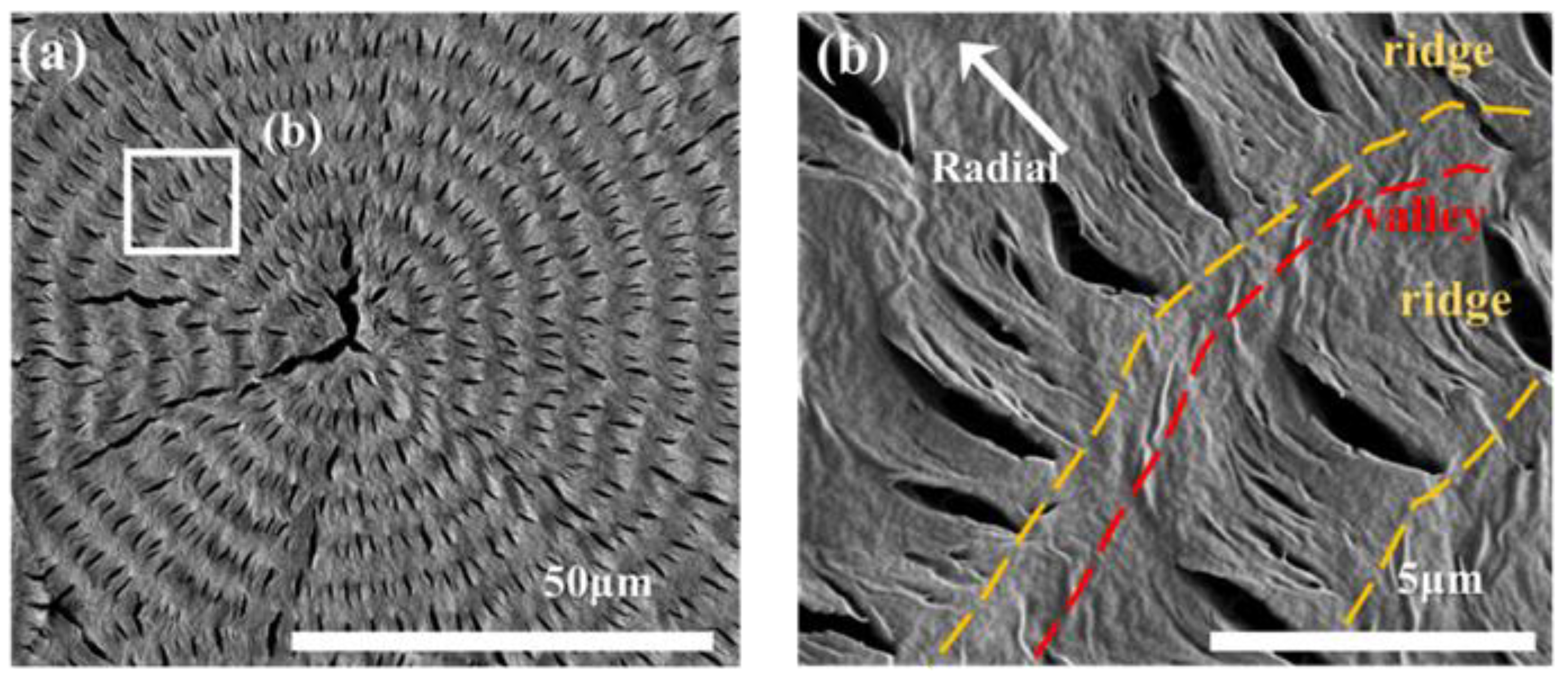
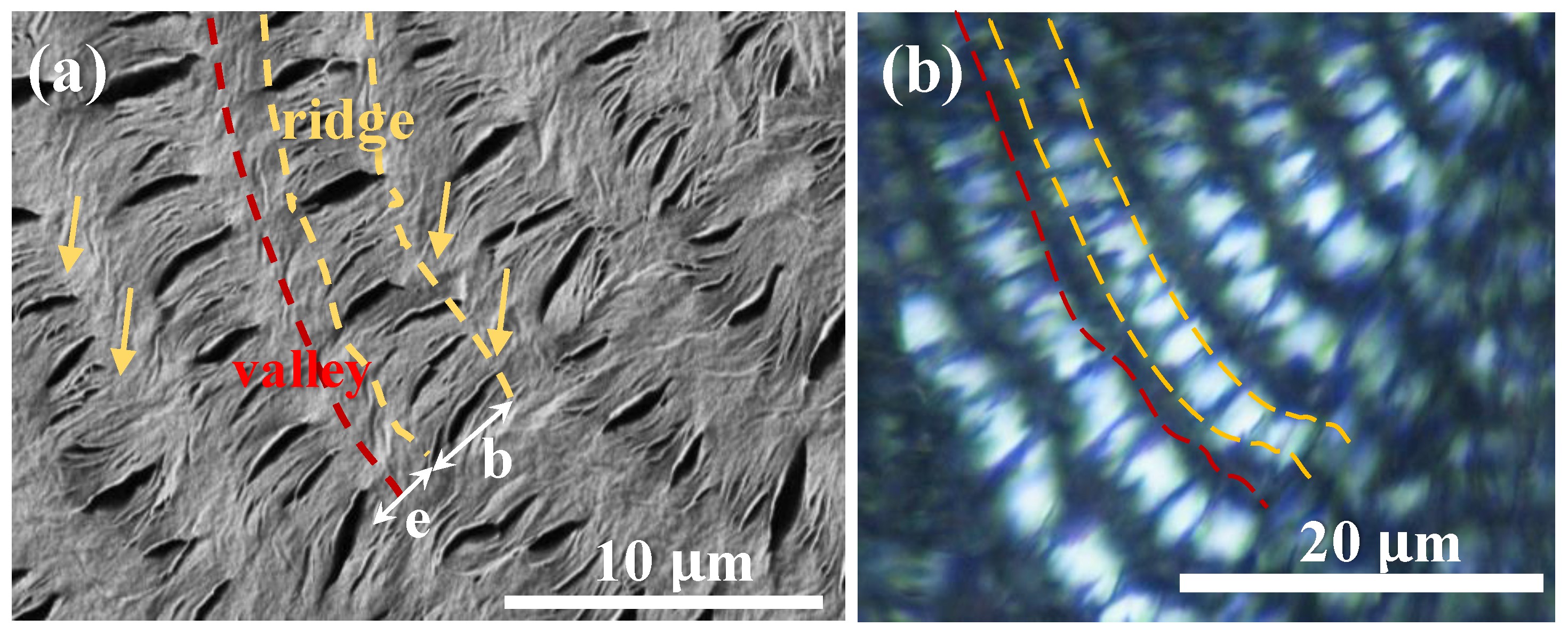
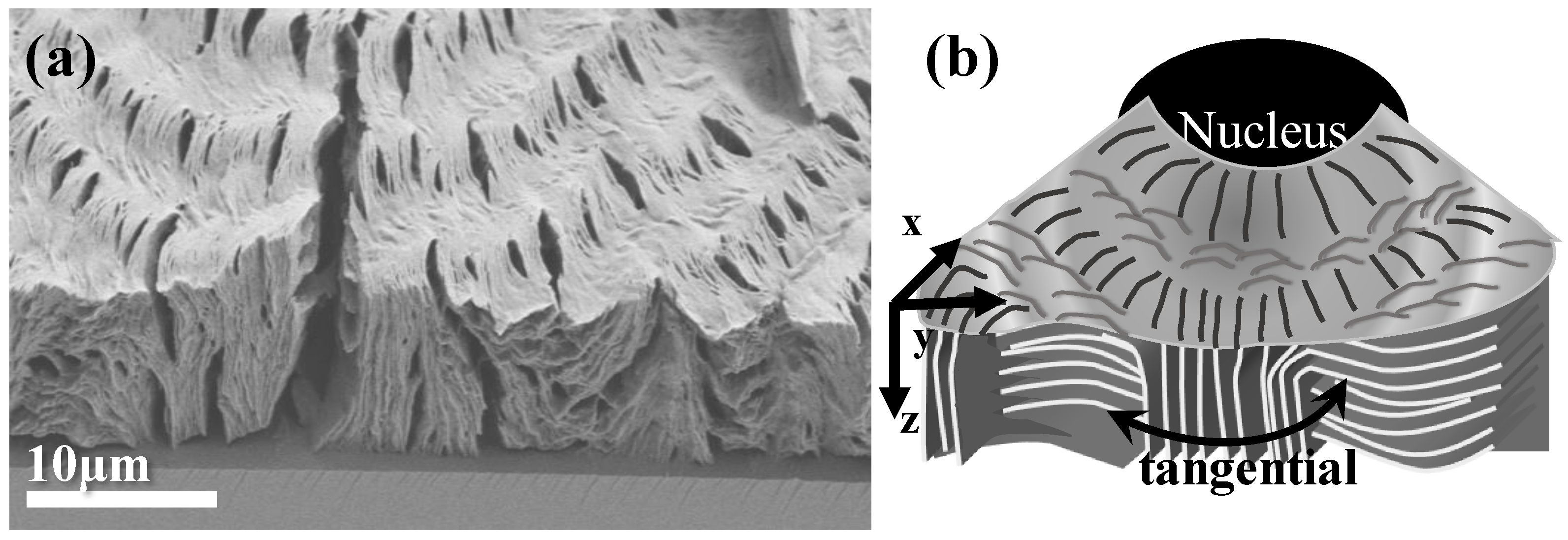
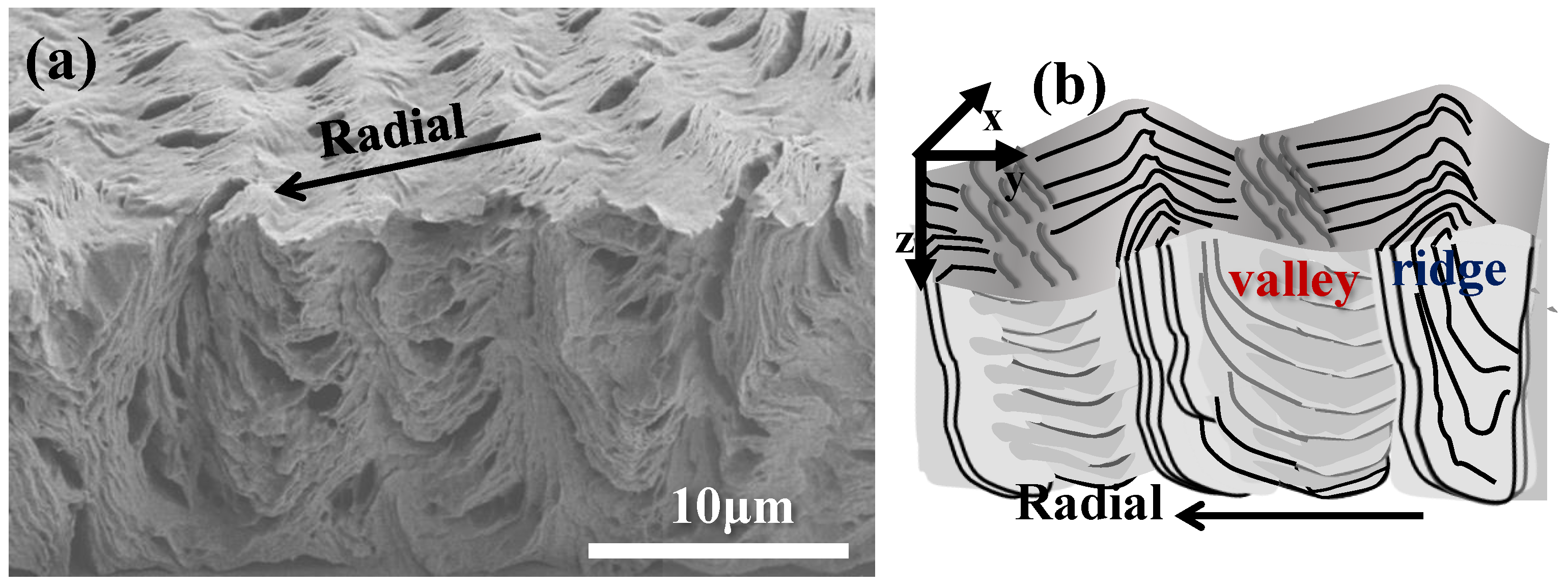

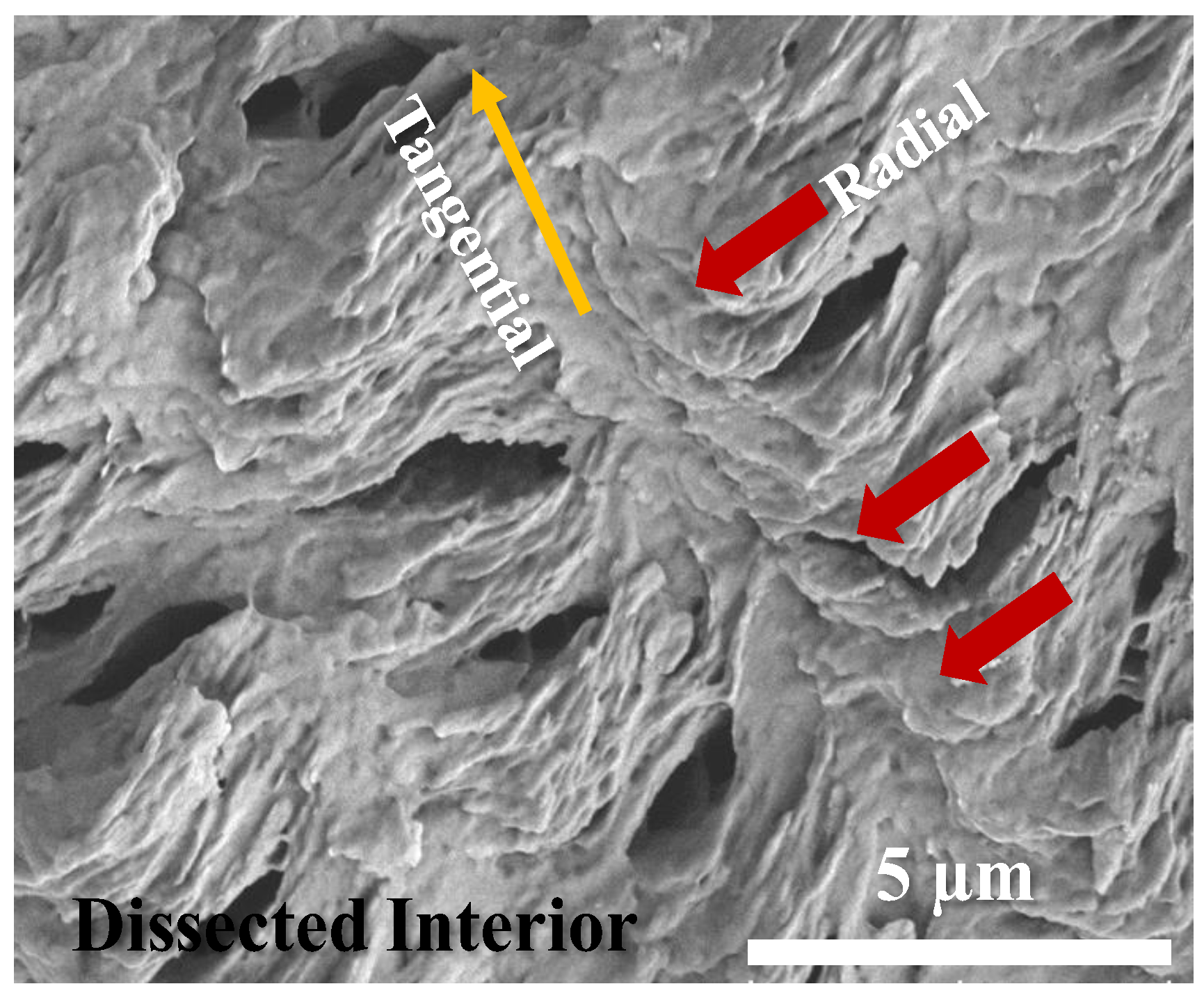
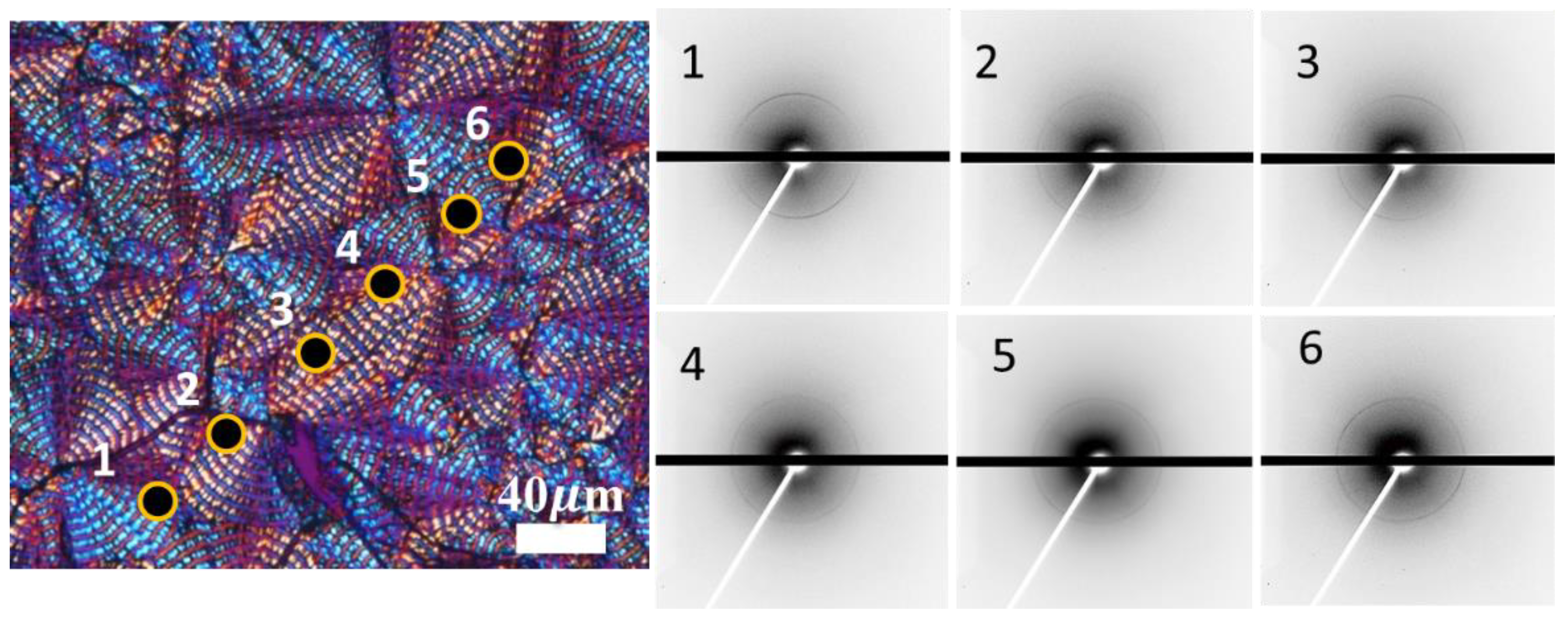
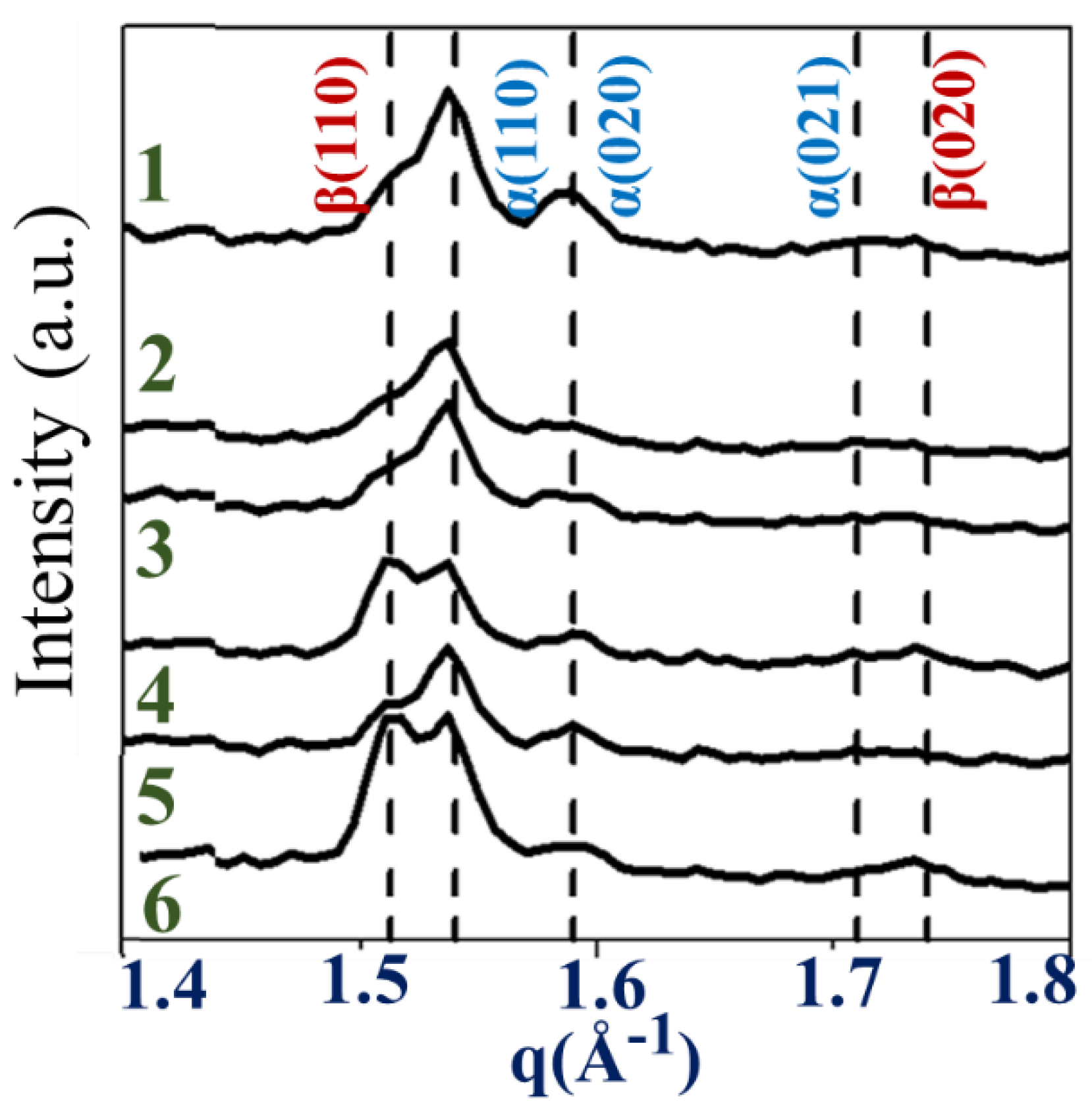
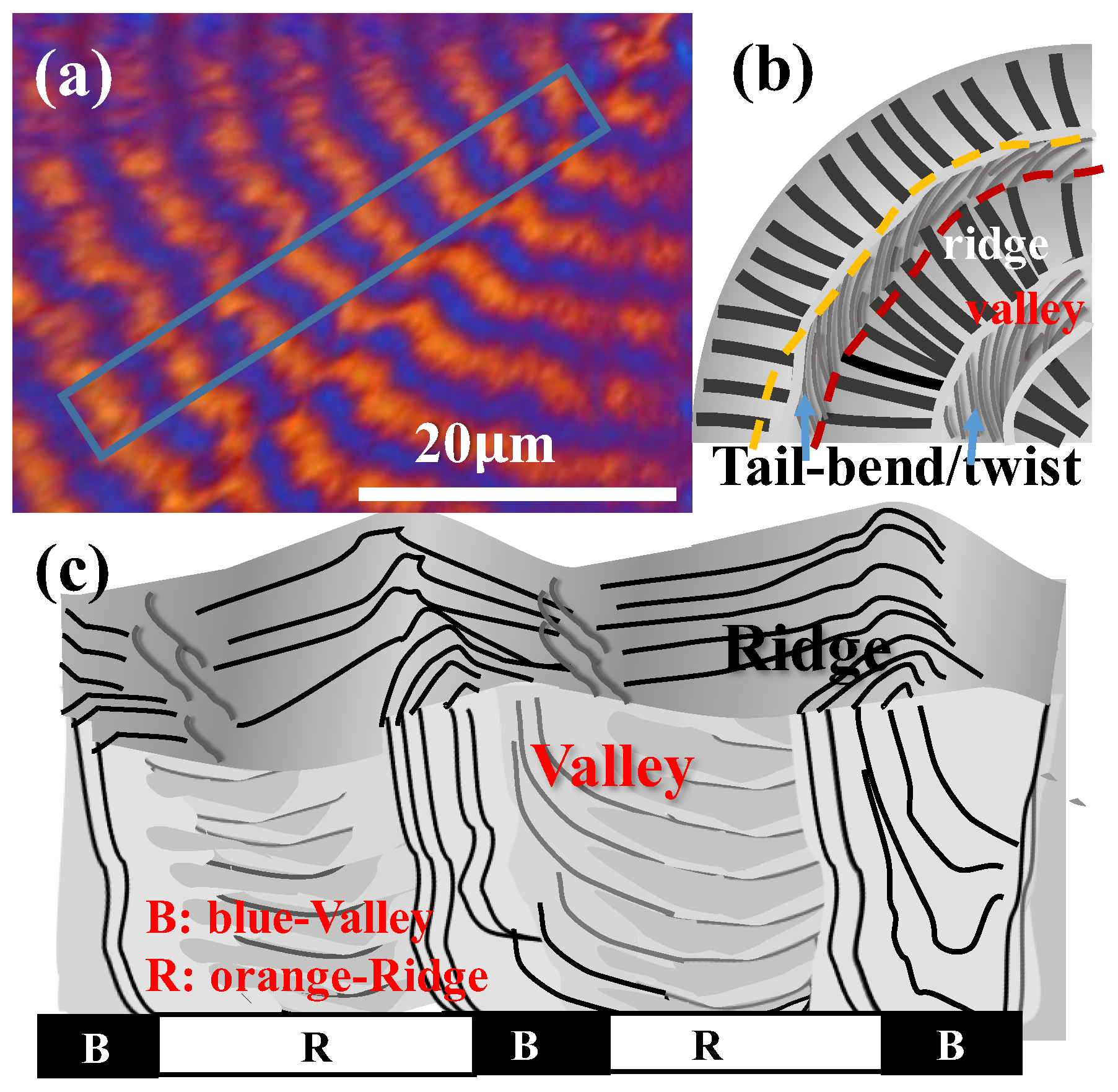
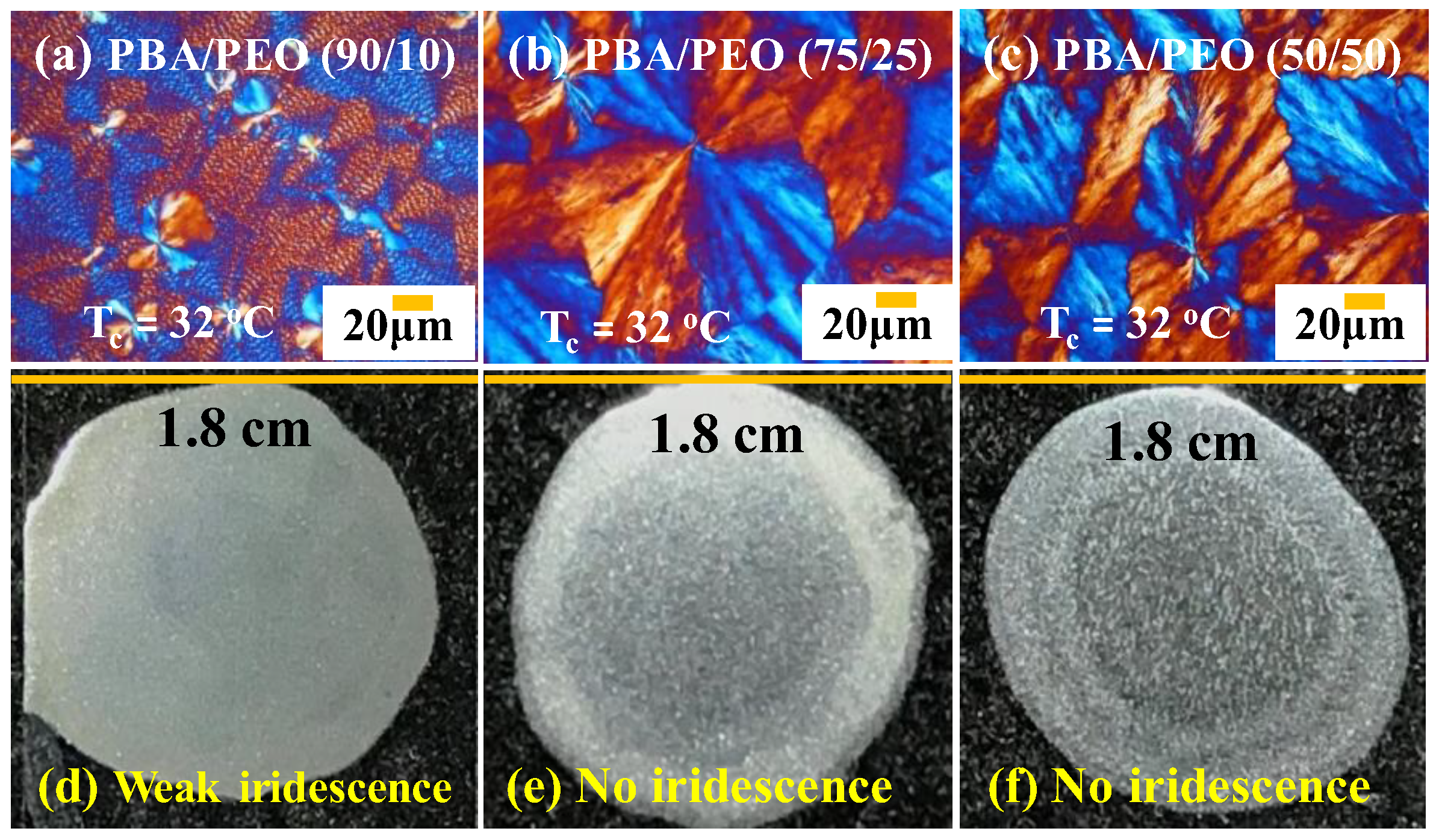


Publisher’s Note: MDPI stays neutral with regard to jurisdictional claims in published maps and institutional affiliations. |
© 2022 by the authors. Licensee MDPI, Basel, Switzerland. This article is an open access article distributed under the terms and conditions of the Creative Commons Attribution (CC BY) license (https://creativecommons.org/licenses/by/4.0/).
Share and Cite
Chang, C.-I.; Woo, E.M.; Nagarajan, S. Grating Assembly Dissected in Periodic Bands of Poly (Butylene Adipate) Modulated with Poly (Ethylene Oxide). Polymers 2022, 14, 4781. https://doi.org/10.3390/polym14214781
Chang C-I, Woo EM, Nagarajan S. Grating Assembly Dissected in Periodic Bands of Poly (Butylene Adipate) Modulated with Poly (Ethylene Oxide). Polymers. 2022; 14(21):4781. https://doi.org/10.3390/polym14214781
Chicago/Turabian StyleChang, Chia-I., Eamor M. Woo, and Selvaraj Nagarajan. 2022. "Grating Assembly Dissected in Periodic Bands of Poly (Butylene Adipate) Modulated with Poly (Ethylene Oxide)" Polymers 14, no. 21: 4781. https://doi.org/10.3390/polym14214781
APA StyleChang, C.-I., Woo, E. M., & Nagarajan, S. (2022). Grating Assembly Dissected in Periodic Bands of Poly (Butylene Adipate) Modulated with Poly (Ethylene Oxide). Polymers, 14(21), 4781. https://doi.org/10.3390/polym14214781






